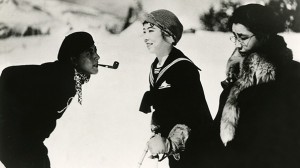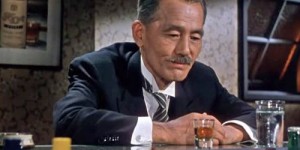For the beginning of this article, go here.
While one could hardly claim that Days of Youth is a major work, it is at the very least an arresting one, and some of its comedy is on a par with the wonderful opening sequence of Passing Fancy (1933) at a naniwabushi recital (when a stray purse gets surreptitiously picked up, investigated, and tossed around like a beanbag by various spectators until the. entire assemblage, reciter included, is dancing about from an attack of lice). One would expect, then, that any serious Ozu scholar would pay some heed to it. Yet all that Richie has done in Ozu — apart from noting at one point that, like all of Ozu’s subsequent films, it shows actors directly facing the camera — is to expand his original commentary on the film (in Film Comment, Spring 1971) from five words (‘A student comedy about skiing’) to seven: ‘Another student comedy, this one about skiing.’ And if one searches in his book for something about Tatsuo Saito — an actor who went on to play the father in I Was Born, But . . . (1932), and figured centrally in several of the twenty other Ozu films where he appeared — one finds that he isn’t even listed in the index; in fact, the only reference to him in the entire book is the observation that he ‘keeps rubbing his hip during various scenes’ in Tokyo Chorus.
Problem No. 3. In those cases where it seems more likely that Richie has seen the film in question, one intermittently finds that he has a rather creative memory. Given the general looseness of his approach, this is perhaps to be expected, and if he recalls the wrong characters in one low-angle shot or some nonexistent ‘golf scenes’ that ‘go on for some time’ in What Did the Lady Forget? (1937) — an upper-class comedy bearing the same sort of relationship to Lubitsch that Days of Youth and That Night’s Wife bear to Hawks and Sternberg respectively — one must admit that mistakes of this sort are common in film criticism.
But when he makes mistakes about An Autumn Afternoon (1962), Ozu’s last film — by most accounts, including Richie’s, one of the major works –- one begins to have serious doubts. Quoting from Kogo Noda’s diary about his work on the script with Ozu –‘”We more or less decide on a man who has a friendship with a woman who resembles his dead wife”,’ Richie adds, “[a lead not followed up by the finished film],’ although anyone can plainly perceive that it was and is, in the bar scenes. Even more oddly, he can describe the final sequence by writing that ‘father and son are in their beds’ when the script fragment reproduced in the book, the accompanying still and the film itself all unmistakably reveal that only the son goes to bed — when indeed, the very point of the sequence rests on the fact that the father doesn’t. And how can he distort this scene even further by implying that the father’s singing of a patriotic song is followed immediately by the end credit?
Some of these lapses and lacunae may partially be a function of the book’s structure. As Richie explains in his Introduction, he conceives of it as a structure approximating to ‘Ozu’s method of creation’: ‘I begin …with a discussion of Ozu’s themes, since that is where he himself would have begun, and go directly into the dialogue, trying to approximate his working method in my own presentation. Later I discuss the way in which he shot and edited his picture, and the effect of the finished film itself.’ This is fine in theory, and certainly it facilitates an exposition of Ozu’s working methods, which is probably the most valuable achievement in the book. Ozu’s manner of constructing dialogue scripts on the later films with his writers — a process involving cards on a table, each card bearing the components of a single scene and worked on as a discrete unit, along with many bottles of sake — provides excellent material, and Richie makes the most of it. (Tokyo Story, one discovers, required 103 days and 43 bottles of sake: it appears that Ozu and his collaborators kept careful track of such details.*) It seems clear that Ozu’s conception of scenes as autonomous blocks was crucial not only to his principles of construction, but also to the depolarised, decentralised focus of his narratives, the absence of a ‘privileged’ subjectivity of approach towards any of his characters or settings. ‘Tokyo’s an attractive city, one character remarks in Early Summer (1951), and Ozu cuts to a view of the city that neither supports nor undermines the comment: the phrase and subsequent shot are treated as formal equivalents in the narrative, but are in no way illustrative of one another; rather like complementary images in haiku, they eschew any sense of cause and effect by accentuating the mutual independence of the separate elements. *Although Richie takes up Ozu’s fondness for spirits, he neglects to relate this to aspects of the films. It is questionable how fruitful such an exercise might be, but it does provide an intriguing clue to an enigmatic pair of camera movements in What Did the Lady Forget?, each of which introduces a scene in a bar by traversing the words on a placard: ‘I drink upon occasion, sometimes on no occasion. Don Quichotte (sic)’ — enigmatic because it is difficult to imagine Japanese audiences understanding this untranslated English inscription; intriguing because it suggests a possible fusion of Ozu’s formalist procedures with a potential capacity for injecting relatively ‘private’ aspects of his personality into these ‘open spaces’. This consideration apart, knowledge of Ozu’s heavy drinking does add some measure of poignancy to Chishu Ryu’s drunk scenes in Tokyo Story and An Autumn Afternoon. (to be continued)


